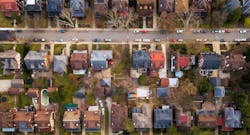Residential buildings account for about 21% of energy use and 20% of greenhouse gas (GHG) emissions in the U.S. That’s a lot of both, in terms of contributing to the current climate crisis and considering President Biden’s goal of cutting U.S. greenhouse gas emissions in half by 2030. Achieving that goal feels daunting given that there are nearly 142 million existing homes in the U.S. and approximately 1.6 million new homes being added to the nation’s housing stock every year. Though new homes built during the last 25 years use significantly less energy, the same cannot be said for the energy efficiency of older, existing homes.
Programs such as the U.S. Environmental Protection Agency (EPA) and U.S. Department of Energy’s (DOE) Energy Star Residential New Construction Program and DOE’s Zero Energy Ready Home Program make improving energy efficiency in new homes relatively accessible and achievable for home builders. New homes also have benefited from code requirements that reduce energy use and improve indoor environments. But bringing existing homes up to those standards has been far less consistent and hasn’t been at a scale sufficient to make a significant impact.
RELATED
- Energy-Efficiency Road Map: Whole-Building Envelope Sealing
- The Need for Resilient Construction Is Real. How Are Home Builders Responding?
- New RESNET Label Provides Home Energy-Efficiency Ratings and Certifications Info
- Energy Retrofits Offer a Practical Way for the Remodeling Sector to Practice Sustainability
Wider Ramifications of Older Homes That Aren't Energy Efficient
And the stakes are higher than just energy use and costs or greenhouse gas emissions. Disadvantaged communities suffer the highest burden of climate change. For instance, people of color and low-income residents have vastly higher rates of pollution exposure: A 2022 Harvard University study that linked 17 years’ worth of demographic data with data on fine particulate pollution from across the U.S., found that the average exposure to dangerous fine particulate air pollution for Black Americans was 13.7% higher than for the White population. The study also showed that as the density of Black populations increased in specific geographical areas, so did their exposure to air pollution. A similar trend occurs in Hispanic and Latino populations, while the opposite holds true for White populations. The result: Disadvantaged populations have more existing health conditions, more potential for asthma-related hospitalization and death, and a higher likelihood of dying from heat-related causes.
Without a focus on building performance, our older existing homes—and their lack of energy efficiency—don’t help the situation, potentially making it even worse.
Upgrading the huge number of existing homes is an immensely complex undertaking, and having a measurable, large-scale impact on building energy efficiency, durability, and occupant health and safety can’t be done without addressing that segment comprehensively. Those involved in weatherization and energy-upgrade programs—as well as remodeling contractors, government and community organizations, and property owners—know the complexity of the task. Technology, process, and consumer understanding are all needed to bring older, existing housing stock up to par and reduce its environmental impact.
Finding Solutions to Boost the Energy Efficiency of Existing Homes
So, how do we shift the focus to improving our nation’s existing homes, at scale? What are broadly useful solutions that can decarbonize our existing housing stock?
The truth is, we don’t know yet.
The U.S. Department of Energy has launched a new effort focused on helping to solve these problems. It recently issued a request for proposals from the decades-old Building America program, which has successfully developed and implemented building-science–based technical solutions to improve building performance in new homes.
Now they’re turning their efforts to existing buildings to encourage a wide array of entities to come together to develop and implement strong, large-scale residential retrofit programs.
The goal is simple, if daunting: Improve the performance of existing homes in great numbers by reducing energy use and greenhouse gas emissions, making our older homes more durable in the face of increasing natural disasters, and improving occupant health, safety, and comfort.
The program is encouraging communities, government and nongovernment organizations, remodelers and contractors, researchers, market-based programs, building product manufacturers, and others to come together to form “Building America Retrofit Solutions Teams” to help solve these issues.
Have ideas? They need them. We all do.
Stacy Kuiper Hunt is principal and co-founder of Confluence Communications, a leading energy and climate-focused education and communications firm. She has spent more than two decades at the nexus of government and industry, helping get technical research into the hands of the people who need it, and is a senior consultant to the U.S. Department of Energy, National Renewable Energy Laboratory, Colorado Energy Office, and others.

